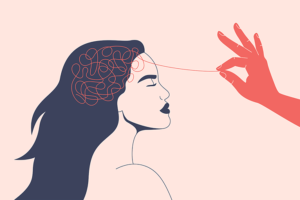When considering different types of treatment for mental health, therapy may be the option that first comes to mind. As the national conversation about mental health has evolved, pursuing therapy has become more and more common — and people are challenging the stigma that surrounds seeking treatment. Indeed, it often seems as though most people have been in therapy at some point in their lives. When making a decision about mental health treatment, it’s important to know that there are different types of therapy to try.
Looking back, I wish I had known about two specific types of therapy: Cognitive Behavioral Therapy (CBT) and Dialectical Behavioral Therapy (DBT).
Understanding CBT
CBT, as defined by the Mayo clinic, is a type of talk therapy that “helps you become aware of inaccurate or negative thinking, so you can view challenging situations more clearly and respond to them in a more effective way.” In simpler terms, CBT is a form of therapy that helps a person reframe their thoughts brought on by mental illness.
As someone who has been in therapy since I was nine years old, I have encountered many different therapeutic techniques, and CBT has worked wonders for me. I was able to use CBT’s three main practices — thought-reframing, acknowledgement/awareness and relaxation/meditation — to navigate my negative thoughts in the throes of depression, anxiety, obsessive-compulsive disorder (OCD), bipolar disorder and more. This method allowed me to sit down and verbalize the issues I was struggling with, which made them feel more “real.” This, in turn, made my negative thoughts easier to tackle. If you’re interested in pursuing CBT, it’s important to learn about its core components.
1. Thought Reframing
Even though this may take time, thought reframing can be one of the most effective tactics in CBT. For example, if you feel like you are losing control of something in your life, thought reframing would require you to evaluate the situation, determine what you do have control of in your life and focus on taking the necessary steps to address the thing you can control. This technique does take practice but can be very beneficial once mastered. In my experience using this technique, I have been able to look at a specific struggle, such as a fear of abandonment, and remind myself of the people who have been there for me and what positivity they bring to my life.
2. Acknowledgment/Awareness
Perhaps when you hear the phrase “acknowledging your feelings,” you may think of “throwing a pity party.” This technique is, in fact, the opposite. Becoming aware and recognizing what you’re feeling are critical steps in overcoming counterproductive thinking. Without fully identifying what you’re feeling, there’s no way to pinpoint what you should be doing to counteract them. For example, when something makes me angry, I don’t tell myself I’m being irrational for feeling that way. Instead, I let myself momentarily feel angry before taking positive steps to combat negative actions that may pop up from that feeling.
3. Relaxation/Meditation
When you think of meditation, perhaps you picture deep breathing exercises. Although that is an important piece of meditation practice, breathing is not the only technique to practice. Relaxation and meditation can consist of other practices like sensory focus, mind cleansing and cognitive introspection.
Sensory focus may be one of the quickest ways to ground yourself. If you’re feeling yourself get to a negative place, looking around you and listing the things you see or hear can bring you back to a more positive headspace. This has been the most helpful tactic for me when I’m in public and start to get overwhelmed. Mind cleansing requires you to let go of negative thoughts that you may hear on repeat in your brain. Cognitive introspection is reflecting on the coping mechanisms you use to handle (or avoid) a situation. Although this technique may be challenging and uncomfortable, identifying negative behaviors and reactions may be exactly what you need to move forward in a more positive way.
Understanding DBT
DBT, a skills-based therapy technique, helps people tolerate and regulate their emotions. It is based on cognitive behavioral principles and focuses on “problem solving and acceptance.”
As defined, DBT is under the “umbrella” of CBT, but it works more with problem-solving than thought reframing. Because DBT is driven by problem-solving, many of the activities done in this type of counseling are more physically hands-on than CBT. I also used DBT in therapy sessions throughout the years which helped tremendously with dealing with my bipolar swings. Having more hands-on techniques to practice has given me things to do instead of living in a negative headspace during my mania and depression.
Typical DBT activities and tactics may include the following:
1. Journaling
Just about any therapist or counselor can vouch for the importance of writing down your thoughts and feelings. However, that’s not the only way to journal when it comes to DBT. Making lists, releasing thoughts without fear of judgment and writing down personal goals are all ways to journal effectively. If you’re new to therapy or are seeing someone new, it can be especially hard to fully express your feelings out loud.
In writing these things down in a journal, you’re still getting those feelings out in a way that is personal to just you. From there, reading your journal to a counselor may be a good transition into being more candid with your feelings.
2. Worksheets
To practice tolerating negative feelings, DBT often encourages using worksheets (many of which are available online) to walk you through the process. You’ll find many practices including opposite emotion thinking, distress tolerance, emotion regulation practices, personal reflections and more.
Opposite emotion thinking is using radically opposite thought processes. For example, if you’re feeling like you need to isolate yourself, go out and do something to get out of the house. Distress tolerance has to do with your reaction to a stressful or distressing situation. A practical way to put that into practice would be to cool yourself down if you feel yourself get physically warm from a triggering situation. In doing that, you’re handling your future reactions by dealing with your current emotional needs. For emotion regulation, a mental check-in can be a beneficial practice to quickly get in touch with what you’re feeling. This can also be done for personal reflections, as well. Most often, these types of practices are done in a group therapy setting, but you can also do them by yourself.
3. Sensory Techniques
Using your senses for your mental health recovery can be extremely effective. Taking note of what you’re sensing can help you achieve more personal awareness and help with grounding techniques, which are most commonly used for anxiety. Using your senses — sight, sound, smell, taste and touch — keeps your focus on what’s physically around you at that moment, not what’s going on in your brain. Sensory practices can be done anywhere and anytime, making it one of the easiest things to do if you can’t access other DBT things. These techniques can also apply to mindfulness in the way that individuals are able to be more aware of thoughts, feelings and surroundings to help ground emotions.
Of course, CBT and DBT are not the only types of therapy out there — and they aren’t cure-alls for every mental illness. Also, therapy isn’t the only thing that helps in your mental health recovery (medication and peer support, among other things, are helpful). However, by incorporating therapy into your recovery journey, you might that you make strides toward healthier thinking and emotional well-being.
Emmie Pombo is an author, beauty writer and mental health advocate from Nashville, TN. She holds a bachelor’s degree in Digital Journalism, and in her free time, she enjoys writing, reading and supporting those in mental health and addiction recovery.
This Mental Illness Awareness Week, the NAMI HelpLine is here for you. If you or someone you know are facing mental health challenges, reach out to the NAMI HelpLine for support, resources and practical next steps. The NAMI HelpLine can be reached Monday through Friday, 10 a.m. – 10 p.m., ET. Call 1-800-950-NAMI (6264), text “HelpLine” to 62640 or email us at [email protected]




